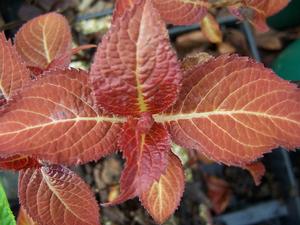Printed at http://www.quackingrassnursery.com/index.cfm/
Hydrangea serrata 'Mountain Mojo'
Mountain Hydrangea
Plant Type:
DECIDUOUS SHRUBSHydrangea serrata 'Mountain Mojo' – From Ed Bowen comes this remarkable seedling selection with beautiful red new foliage – a richer, deeper but a brighter red than 'Kiyosumi'. In addition this gorgeous Mountain Hydrangea exhibits even similar but better flowers than 'Kiyosumi'. All white sepals exhibit a picotee red scalloped margin. White fertile flowers in the central ring age pink. Full morning sun will engender richer foliage tones. Though we are designating this beautiful shrub to be bud hardy at the USDA zone 6 perhaps 5b, Ed Bowen who resides in zone 7 thinks (with a question mark) that this plant may be bud hardy through zone 5. These are full sun tolerant given their soil is fertile and constantly moist. For gardeners towards the northern end of its range spring planting is advised. Established potted Mountain Hydrangea, cutting grown.
Characteristics and Attributes for Hydrangea serrata 'Mountain Mojo'
Season of Interest (Flowering)
- Summer
Season of Interest (Foliage)
- Spring / Summer / into Autumn
Autumn Interest
- Autumn Leaf Color
Light
- Full Sun
- Mostly Sunny
Attributes
- Border
- Foundation
- Specimen
- Accent
- Labyrinth
- Shrub Border
- Collector Plant
- Hedge
Growth Rate in the Garden
- Moderately Fast
Soil
- Fertile
- Draining
Origins
- Garden Origin
Propagated By
- Cutting Grown
Genus Overview: Hydrangea serrata
This species originates in the mountains of Japan and Korea. Though it is purportedly hardier than H. macrophylla we seldom see flowers in USDA zone 5b; as such we are listing all of the following cultivars as better doers in zones 6 to 9. The ovate to lanceolate foliage tends to be narrower than its close cousin, H. macrophylla. The smaller leaves support an over all more delicate appearance. And as with H. macrophylla there are also both lace caps and mop heads occurring in this species and will be noted below. We've seen this group also listed as H. macrophylla var. serrata. All prefer fertile soil to sandy loam. All of the following cultivars are cutting grown.



